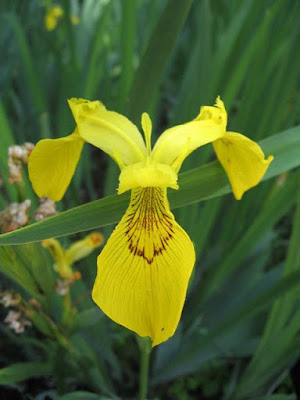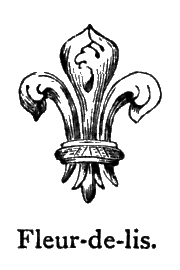 |
| Yellow Iris by A. Barra CC BY 3.0 |
" ... what sayest thou, my fair flower-de-luce"
"Awake, awake, English nobility!
Let not sloth dim your horrors new-begot:
Cropp'd are the flower-de-luces in your arms"
- Henry VI, Part I, Act I, Scene 1
"I am prepared: here is my keen-edged sword,
Deck'd with five flower-de-luces on each side"
- Henry VI , Part I, Act I, Scene 2
"... have I a soul,
On which I'll toss the flower-de-luce of France."
- Henry VI, Part II, Act V, Scene 1
"... lilies of all kinds,
The flower-de-luce being one! O, these I lack,
To make you garlands of, and my sweet friend,
To strew him o'er and o'er!"
- The Winter's Tale, Act IV, Scene 4
The Flower-de-luce, more commonly known as the Fleur-de-lis, is a
popular symbol in heraldry. During the medieval period it was
particularly associated with the French monarchy. In Henry V, Henry
refers to the French princess Katharine as "my fair flower-de-luce."
Likewise when Shakespeare mentions the flower in Henry VI Part I and
Part II, he is referring to its use as France's heraldic emblem.
 |
| Illustration from Chambers's Twentieth Century Dictionary (1908) |
Other spellings of the flower include Fleur de Lys, Flour de Lis, Fleur
de luce, Flour Delyce, Flour Deluce, Flour de Lis, Floure De Luce and
Floure Delice.
There has been much debate among scholars as to what type of flower the
Flower-de-luce or Fleur-de-lis is. In French fleur means flower and lis
means Lily. Shakespeare himself refers to the flower as a Lily in The
Winter's Tale. Likewise a contemporary of Shakespeare, St Francis de
Sales (1567-1622) described the "beautiful flower-de-luce" as a flower
with "six leaves whiter than snow, and in the middle pretty little
golden hammers." (The Mystical Flora of St. Francis de Sales) Chaucer
also seems to equate the Fleur-de-lis with the Lily, in The Canterbury
Tales he writes "Her nekke was white as the Flour de Lis."
However other writers of the period distinguish the Fleur-de-lis from
other plants. In The Shepheardes Calender (1579) Spenser writes:
Strow mee the grounde with Daffadown-Dillies,
And Cowslips, and Kingcups, and loved Lillies;
The Pretty Pawnce
And the Chevisaunce
Shall match with the fayre Floure Delice.
In Pan's Anniversary (1620) Ben Jonson writes, "Bring rich Carnations,
Flower-de-luces, Lillies." In his Essay of Gardening (1625) Francis
Bacon lists "the double white violet; the wallflower; the
stock-gilliflower; the cowslip; flower-delices, and lilies of all
natures."
The herbalists William Turner and John Gerard identified the Flower-de-luce as the Iris (Iris pseudacorus), also known
as the Yellow Flag. It was
also identified, by later botanists, as the Blue Flag (Iris veriscolor).
 |
| Blue Flag (Iris veriscolor) https://digitalcollections.nypl.org/items/510d47dc-861a-a3d9-e040-e00a18064a99 |
According to Henry N. Ellacombe the confusion between Lily and Iris is not surprising.
"Botanical classification was not very accurate in his [Shakespeare's]
day, and long after his time two such celebrated men as Redoute and De
Candolle did not hesitate to include in the "Liliacae," not only Irises,
but Daffodils, Tulips, Fritillaries, and even Orchids." (The Plant-Lore
and Garden-Craft of Shakespeare). It was only during the 19th century
that the Iris ceased to be known as a Lily.
The History of the Name
There are a number of stories as to how the Fleur-de-lis derived its name.
Some believe it is a corruption of "Fleur de Louis", named after either King
Louis VI (1081-1137) or King Louis VII (1120-1180) of France, who placed it on their coat of arms. However the Fleur-de-lis had been
used by the French monarchy for a number of years and appears on the
seal of Philip I in 1066.
One legend says that the Fleur-de-lis was the flower given
to the King of the Franks Clovis (466 - 511) by the Virgin Mary at his baptism. Lilies were the flower of the Virgin Mary. A similar legend recalls that when King Clovis was
faced with defeat in battle, he prayed to the
god of his Christian wife, Clothilde and won. He converted to Christianity and placed the flower on his banner in reverence to the Virgin Mary. Since that
time the Fleur-de-lis has been taken to symbolize all the Christian
Frankish kings, most notably Charlemagne who was crowned Holy Roman
Emperor in 800. He is reported to have been presented with a blue banner
covered with golden Fleur-de-lis by Pope Leo III at his coronation.
The French kings traced their heritage back to Clovis who united France
under his rule in the 5th century. Interestingly as the heraldist Arthur
Charles Fox Davies noted "the names Loys, Lois and Louis are derived
from the name Clovis and Loys was the contemporary spelling used by the
kings of France until Louis XIII." (A Complete Guide to Heraldry). So it
has been claimed that Fleur-de-lis is a corruption of "Fleur-de-Loys."
Another theory for the Fleur-de-lis is that it derives its name from
the river Lys, which is situated on the French borders with Flanders (modern day Belgium) and where the flower grows in abundance. The heraldist François Velde noted "One
species of wild iris, the Iris pseudacorus, yellow flag in English, is
yellow and grows in marshes ... Its name in German is Lieschblume ...
but Liesch was also spelled Lies and Leys in the Middle Ages. It is easy
to imagine that, in Northern France, the Lieschblume would have been
called "fleur-de-lis." This would explain the name and the formal origin
of the design, as a stylized yellow flag." [Source]
Type: Perennial
Height: Up to 5 feet
When to Plant: Mid-summer to early autumn
Flowers: Summer
